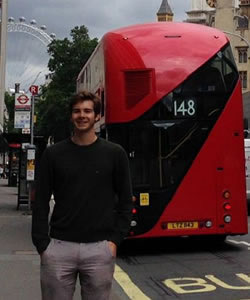The Czech Republic finally made it into U.S. news headlines. It did not take much, just a nationwide protest and a well-thrown shoe at the German president’s head. But in the spirit of soon-to-be and long anticipated festivities, let us segue into the tradition of the Velvet Revolution from a brief overview of St. Nicholas Day, and see if we can hit two precedents with one shoe.
If you wander down the streets of Prague on December 5, you will notice the ubiquitous presence of an odd trio. Dressed in papal attire is St. Nicolas (Mikuláš), flanked by an angel (anděl) and a devil (čert). To all you die-hard Santa fans, you may be disappointed by this skinny, holy usurper; but let’s face it, it’s not as weird as Holland where St. Nick retires to Spain during the summer and meanders the streets of Amsterdam during the Christmas season flanked by “six to eight black men” (but it makes for a much more entertaining story—just listen to David Sedaris). As St. Nicolas walks the streets of Prague, he will stop children and demand a poem, a carol, and a confession. If these requirements are fulfilled, the angel will reward candy and treats; if not, the devil will put the kid in a sack and take him or her back to hell. It seems a steep price to pay, but let’s face it, what’s eternal damnation to a kid when presented with the opportunity of candy?
Fear and festivity aside, St. Nicolas Day holds more celebratory value than Christmas (a day where Czechs watch “fairy tales” and gorge themselves on delicious homemade treats), and more presents than Christmas Eve.
The other tradition, celebrated on November 17, typically lacks the St. Nick trifecta, but this year it happened to contain an overabundance of devils. To celebrate the anniversary of the 1989 Velvet Revolution, Czechs crowd into squares around Prague, particularly Wenceslas Square, to demonstrate their freedom and liberation from Soviet-enforced totalitarianism. This year, Czech president Milos Zeman tried a new approach to tradition. Instead of commemorating the anniversary by lighting candles at the official monument, Zeman decided to appear with the presidents of Germany, Slovakia, Hungary, and Poland at the unveiling of a new memorial at a different 1989 protest site. This may have even been endearing to the populace, seen as a sentimental act stressing the international importance of the Velvet Revolution.
Unfortunately, the already immensely unpopular president decided to dedicate his speech to the reestablishment of Russian diplomatic friendship, all the while buttressing his rhetoric with Communist nostalgia. Had President Barack Obama commended King George III on Independence Day, the United States could have paralleled such a political blunder. Accordingly, the citizens of Prague held a mass demonstration against Zeman, holding up red cards to signal his soccer-like ejection from the political arena. They drowned out his speech with patriotic song and showered the heads of state in debris (and a few shoes).
Readers may cringe at the international diplomatic implications of pelting world leaders with blunt objects, but in terms of the Czech Republic Zeman’s act of political idiocy may have caused a much-needed reinvigoration of Czech participation in the political landscape. Let us hope that in the future Czechs will use their shoes less as items to buffet presidents and more as much-needed articles to get them to the voting booths.

